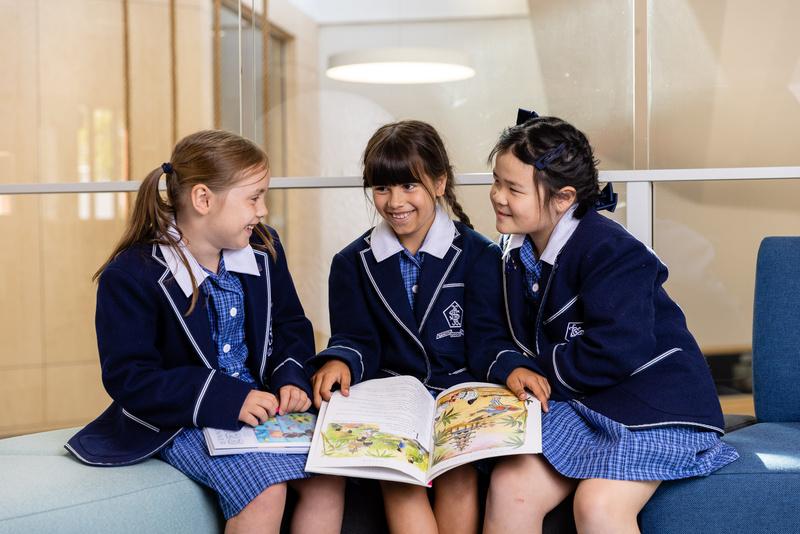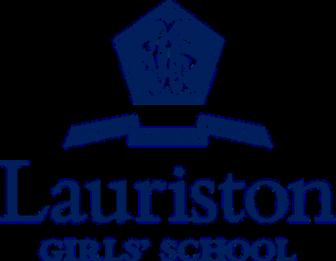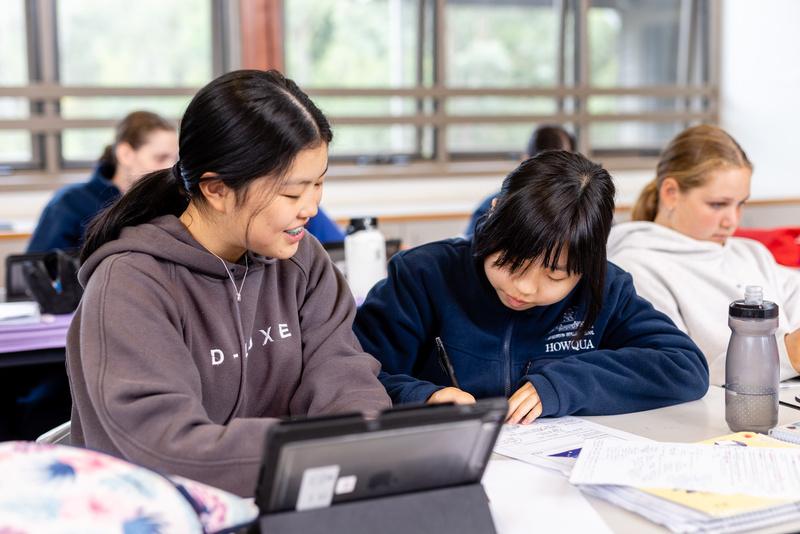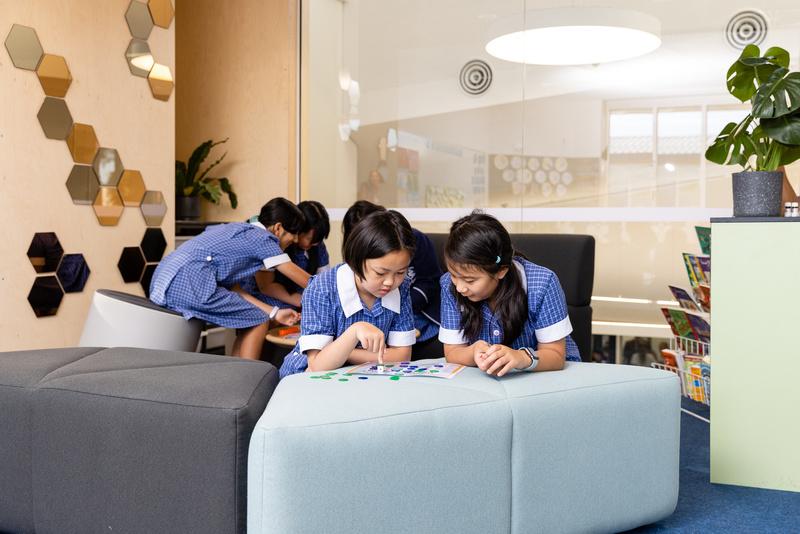
Beyond Words
Empowering Girls Through Reading and Literacy
Contributors
Susan Just, Principal
Chris Toms, Vice Principal & Head of Junior School
Lindy Grahn, Assistant Principal - Learning and Innovation
Kate Hehir, Assistant Principal - Junior School (Curriculum and Learning)

A snapshot of the Lauriston approach 3 How we continue to develop reading skills throughout the primary years 9 How our NAPLAN results support our approach 4 The interventions we have in place when we identify those who are struggling 10 How our Prep to Year 2 students learn to read 5 In Summary 18 Contents How we continue to build on fluency, comprehension and vocabulary in Senior School 12 How we build capacity for reading through our library services 14 Glossary of Terms 19
A snapshot of the Lauriston approach
This eBook provides a snapshot of Lauriston’s approach to reading - each subject area provides ongoing support in the development of reading through the provision of knowledge-rich curriculum materials, and skills development is a responsibility for all subject disciplines.
The Grattan Institute recently published the report, The Reading Guarantee: How to give every child the best chance of success The ability to read is a core life skill and evidence collected by the researchers of this report state that one in three Australian students are not mastering the reading skills they need. At the core of the recommendations put forward in the report is the implementation of a phonics-based reading program along with the provision of knowledgerich curriculum materials and effective assessment tools In addition, there is a recommendation for all schools to use reading assessment tools at least twice a year to screen students from Prep to Year 2, in the transition to Senior School and for any new school entrants. Intervention would be required for students who do not meet the screening benchmarks.
According to NAPLAN, Reading performance has been relatively stagnant over the past 10 years, with 30% of primary students in 2023 not reaching the proficient level. Years 7 and 9 NAPLAN results in Reading have not significantly improved One might assume that poor results in Reading would be specific to socially economically disadvantaged or, First Nations students, or those students who live in rural areas. However in Victoria, the most socially economically advantaged regions count for approximately 25% of students who are not proficient.
For primary-aged children, mastering the mechanics of reading in the early years is essential and the report recommends a phonics program Once students have mastered decoding and word recognition, focus can then be given to identifying the meaning of the text Students need to develop strategies for reading comprehension skills, which include activating prior knowledge, questioning, summarising and making inferences. Developing a rich vocabulary and background knowledge supports students as they learn to understand what they read
For secondary-aged young people, they should have mastered decoding by the start of their secondary years, developed strong comprehension skills and built a large vocabulary Senior school reading further develops fluency, comprehension and a more sophisticated vocabulary.
3
How our NAPLAN results support our approach
At Lauriston we track our NAPLAN performance and use the data to determine trends across each cohort at years 3, 5, 7 and 9.
We can track improvement in Reading and Numeracy over time, which informs our approaches to teaching and allows us to target both individual students and year cohorts where intervention is needed
From 2018 to 2022, with the exception of 2020 when students were not tested due to the COVID-19 pandemic, our NAPLAN Reading results were above that of the State and Australia Our Year 7 students in 2022 were approximately 1.84 years ahead of the State mean in Reading and our Year 8 students were approximately 1 72 years ahead of the State mean.
We do, however, closely analyse specific year-level cohorts where we may find an upward or downward trend in Reading results This data provides us with an opportunity to consider whether specific whole-yearlevel approaches to reading are required
The NAPLAN Reading results are also used in conjunction with the additional data that we collect to provide specific interventions for individual students
In 2023, data reporting from NAPLAN was changed to a new adaptive format and thus while Lauriston Reading results are above State and Australia levels, we cannot compare these results with previous years Of the 99 students who participated in Year 7 NAPLAN, 50% were in the top Exceeding category and of the 91 students participating in Year 9, 45.1% were in the top Exceeding category.
4
How our Prep to Year 2 students learn to read
Literacy is taught daily in our Learning program and is evident in the classroom as either an explicit lesson or embedded in everyday, real-life learning experiences.
Literacy learning is purposeful, and our students have a strong understanding of ‘why?’ , shared through learning intentions, clear objectives and personal goals
Phonics - the method of teaching students to read by correlating sounds with symbols in an alphabetic writing system - and word knowledge are taught from Prep to Year 6 through a systematic phonemic-based method
All classroom teachers have participated in SMART Spelling professional learning to ensure sound understanding, a consistent approach and common language From their first day in Prep, students begin developing their phonics and word knowledge based on SMART Foundation, extending throughout the School into Year 6, where students explore more complex word origins including Greek and Latin roots.
Reading is also taught systematically using a phonemic-based approach which links to the Spelling program Children learn to read a wide variety of texts, including decodable readers early on to free choice chapter books in middle primary Targeted Reading groups teach specific comprehension and fluency skills to develop understanding.


5
How our Prep to Year 2 students learn to read (continued)
The Lauriston curriculum is informed by Australian Curriculum (Version 9). Reading and Writing are explicitly taught in context and in isolation.
1 | Oral language development
Early readers are explicitly taught to manipulate syllables and sounds to help establish the skills needed to read and write
2 | Phonics instruction
Students learn the relationship between letters and sounds. They start by learning letter–sound correspondences and then move on to blending sounds together to form words.
3 | Sight words
Alongside phonics instruction, students learn to recognise highfrequency words (sight words) that do not always follow phonetic rules for example, the or talk These words are often taught through memorisation and repetition, as they appear frequently in written text
4 | Shared reading Teachers read aloud or with students, using a variety of books or texts on the interactive television, which students follow. This allows students to see and hear fluent reading and exposes them to a variety of texts and genres (for example, narratives, information reports, persuasive texts). Comprehension is explicitly taught through questioning and analysing the text.
5 | Guided reading
This involves small group instruction where our teachers work with students at their instructional levels, providing support and guidance as they read text that is slightly above their independent reading levels using decodable texts when appropriate
6 | Word work activities
Hands-on activities such as word building, word sorting and phonemic awareness games help reinforce phonics skills and word recognition.
7 | Writing activities
Writing and reading are directly related. Students may engage in writing activities where they practise spelling words they’ve learned, write sentences across different genres and engage in activities that reinforce their understanding of phonics and sight words
In addition to the methods above, students are also provided with takehome books at their independent reading levels which they are expected to read with their parents each night.
6
How our Prep to Year 2 students learn to read (continued)
To implement an effective Reading program, the teachers regularly assess Prep to Year 2 students.
Regular assessments provide teachers with valuable information about each student’s reading development over time. By monitoring progress, teachers can identify areas of strength and areas that need additional support, allowing them to tailor instruction to meet individual student needs.
Assessments also help identify students who may be struggling with reading at an early stage. Early intervention is crucial for addressing reading difficulties before they become more significant barriers to learning. With timely intervention, students can receive the support they need to develop reading skills. Regular assessment allows teachers to communicate with parents about their child’s reading progress.
At Lauriston, teachers create many opportunities for students to make connections and link English skills in a myriad of ways.
In Prep and Year 1, allocated roles such as reporter, focus girl and photographer are responsibilities students perform within the Investigations program, providing meaningful opportunities in which to use and develop literacy skills. The Prep letter walk involves children exploring and searching for letters in their local community. When visiting the zoo, students read and record facts about animals, while navigating the language of position and direction (“How do we go to the seals?”) through words such as left and right.
7
How our Prep to Year 2 students learn to read (continued)
Literacy is also embedded in STEM projects such as the Year 1 augmented reality fairytale recently crafted through the use of the creative storytelling 3D Toontastic app. Year 3 use LEGO kits to allow children the freedom to create and see their narratives come alive through play and construction. Once children can actively visualise their narratives, they can more easily record them in words.
Procedural texts gain purpose when recording actual experiments in Science, such as making ice cream or constructing a pirate hat. Collecting and recording family recipes allows procedural texts to become a valued activity in our Celebrations unit and a way to share traditions within our School community.
Writing with a purpose is also evident through letter writing and the excitement of writing and posting a postcard to a friend or relative, or a letter to Santa in the North Pole. These are all opportunities for children to share their thoughts, feelings and experiences with a wider audience.
Annual events such as the Prep to Year 2 Market offer engaging literacy experiences from making advertisements, recording films of items for sale to constructing stall signs for visitors.
Speaking and listening skills come alive for children when they are required to share or present to an actual audience. Readers Theatre is a popular drama approach for developing reading fluency in Year 3, where the girls love to read a script and perform to their peers.
The importance of thorough research and documentation become more important when Year 4 students present their First Nations project as an

How we continue to develop reading skills throughout the primary years
From Year 3 through to Year 6, Literacy continues to be taught every day.
The PAT Adaptive (Reading) assessment, NAPLAN Reading test and Fountas & Pinnell Benchmark Assessment Systems (F&P) all provide valuable tracking information for teachers about the reading ability of each student, along with WARP fluency tests, Year 5 Read Theory, CARS and STARS, and SWIFT analysis.
The F&P are accurate and reliable tools for identifying the instructional and independent reading levels of all students and document student progress through one-on-one formative and summative assessments. All Junior School teachers are expected to listen one on one to students using F&P and document progress. In Years 3 and 4, readers are sent home based on students’ current F&P levels
Junior School teachers report on ‘Reading and Viewing’ as a standalone subject every term. Results are shared with parents via continuous reporting and in the two semester summary reports Lauriston’s grading system allocates a number between 1 and 5, with 3 equaling ‘working at level’
Teachers explicitly teach reading skills and have different focuses each term. A general guide would be:
Year 3
Author’s purpose
Compare and contrast
Literal and inferred reading
Supporting detail
Sequencing
Fluency – pausing, rate, expression
Reader’s Theatre scripts and performance
Features of nonfiction texts
Year 4
Cause and effect
Summarising
Fact and opinion
Year 5
Main idea
Making inferences
Sequencing, finding similarities and differences
Predicting
Paraphrasing
Concluding, summarising and inferring
Cause and effect
Inferring
Fact and opinion Point of view
Year 6
Retelling
Main idea
Inferring
Poetry – analyse and annotate poetry using SWIFT analysis method
Making predictions
Inferring and understanding perspective
Book club –summarising, evaluative language, making connections
9
The interventions we have in place when we identify those who are struggling
When teachers identify students who are struggling with reading, they assess students using the standardised York Assessment of Reading for Comprehension (YARC) assessment.
Specific intervention
When classroom teachers identify that Prep students are having difficulty acquiring early reading skills, we provide small group support (not intervention) to focus on pre-reading skills such as oral language (hearing sounds in words, identifying rhyme, manipulating phonemes) and building phoneme-grapheme correspondence. These skills are taught through games and shared reading.
In Years 1 and 2, MiniLit Sage is a tier 2 small group Reading program for students in the bottom 25% of the expected range for their age group. The program provides explicit instruction in phonemic awareness, systematic synthetic phonics for reading and spelling, letter formation, and connected text reading. The MiniLit Sage is delivered four to five times per week for 45-minute lessons. The program can be delivered by teachers, learning support teachers, teacher aides or special educators, and is designed to be delivered to small groups of up to four students, but it can also be used on a one-to-one basis. At Lauriston, we have provided professional learning to our Individual Differences teachers who are trained to offer the MiniLit Sage and the MacqLit.
In Years 3 and 4, MacqLit is an explicit and systematic reading intervention program for small groups of older low-progress readers. It provides teachers with a comprehensive sequence of lessons that includes all the key components necessary for effective reading instruction: phonemic awareness, phonics, fluency, vocabulary and comprehension. This program is effective for students who fall in the bottom 25% of a standardised Reading test or curriculum-based measure.
10
The interventions we have in place when we identify those who are struggling (continued)
For students in Years 5 and 6, Sounds-Write is a quality evidence-based first linguistic phonics program Its purpose is to provide classroom professionals with a comprehensive system with which to teach Reading, Spelling and Writing This program is effective for students who fall in the bottom 25% of a standardised Reading test or curriculum-based measure, and who have particular difficulties in the area of word recognition.
As students move into the Senior School, our Individual Differences teachers provide specific Literacy support for students who continue to require capacity building in their reading. The Literacy support is tied closely to the work students complete in English and their other subjects
We continue to use the standardised YARC assessment for secondary students and the Allwell testing provides specific data on reading levels. The Allwell testing, NAPLAN results and Progressive Achievement Tests (PAT) provide valuable data on individual students who may be struggling with reading and also data on the continued Reading development of each cohort.

11
How we continue to build on fluency, comprehension and vocabulary in Senior School
English Faculty members focus on text choices for each year level as a means of continuing to build on the comprehension and vocabulary skills developed in the primary years.
For example, Oscar Wilde’s short stories is the text choice in Year 7. These are a manageable length whilst exposing students to a more sophisticated vocabulary and writing style. In Year 8, students study a dystopian text The Giver, which is a short novella, building on the amount students need to be decoding and interpreting.
In Years 7 and 8 the English curriculum includes the wider Reading program, which comprises of a fortnightly lesson in the library where students are encouraged to read texts that are outside of their designated set texts. The aim is to broaden students’ vocabulary, encourage reading for pleasure, expose students to different perspectives and highlight the importance of dedicated reading time.
Years 7 and 8 students study a grammar and comprehension textbook that teachers embed into the curriculum. It contains tasks aimed at improving students’ metalanguage and the fluency of their writing. English teachers try to match the content of the grammar book with their unit so that the skills can be transferred and reflect improvement in students’ results.
As students move up through the senior years, they are introduced to a variety of non-fiction texts. The outcome of assessment for these texts is the ability to decode information and to identify the direction of an argument.
12
Text choices become more sophisticated, introducing Shakespeare, classical texts and literature from a variety of literary forms.
Outline of texts/assessments in each senior level:
Year 10 English
Text types
Film, political speech, novel, play and poetry as well as non-fiction editorials, blogs, letters and articles
Types of assessment that show a steady improvement
Short film analysis, 3–4 minute speech, Creative story, analytical text response, oral analysis decoding a passage, analytical text response, argument analysis response, poetry passage analysis
Year 11 English
Text types
Play, speech, short stories, interviews, articles, editorials and letters
Types of assessment that show a steady improvement
Personal response linking text to own experiences and observations, analytical text response, creative story and reflective commentary, oral presentation, argument analysis
Year 12 English
Text types
Greek theatre/play, shortstories, speech, monologues, articles, letters, opinion pieces and poetry
Types of assessment that show a steady improvement
Analytical text response, creative story and reflective commentary, oral, exam
For students identified as struggling with reading, the English teachers provide scaffolded materials during each unit of work, which include character descriptions, timelines of key events, key words and vocabulary and chapter summaries. Audiobooks are offered to students which they can listen to and then record themselves reading the key moments of each chapter.
Reading aloud is encouraged in class time and revision sessions, and masterclass lessons are offered to students to support or extend their understanding of texts.
Our Individual Differences teachers offer Learning Enhancement lessons to students with specific Literacy and Numeracy needs, while our students in Years 11 and 12 may be provided with one-on-one support with Individual Differences teachers who target reading and writing skills
13
How we build capacity for reading through our library
In the Junior School, the library supports and promotes reading in the following ways:
The library is a fully functioning hub of resources for learning and reading pleasure in the Junior School. It is a warm and friendly place where students can come during lunch break to browse the shelves, read, chat, or play card and board games.
The Teacher-Librarian is constantly reading book selection journals (for example, Magpies) and assessing the resource collection with input from teachers and students.
Displays in the library are a crucial method of encouraging students to read. Displays are colourful and attractive during special events (for example, Book Lovers Day, Lunar New Year) or to support topics covered in classes
Each class has a formal lesson each week in the library when the students borrow books and have a formal lesson on research skills and literature appreciation
Book clubs are established for most year levels where books are chosen for a levelled group according to Fountas & Pinnell groupings/tested reading levels
Book Week in Term 3 is a very special time – each day the library hosts an author who runs a workshop with each class in the Junior School Students research these authors prior to Book Week and the Year 5 students write and present a welcome and farewell speech for the visitor at each of these workshops.
The library often asks grandparents to come in to read a story or talk about their own childhood reading stories to our students.
Each year there is an enrichment opportunity for enthusiastic readers and writers to attend the Writers’ Festival
14
How we build capacity for reading through our library (continued)
In the Senior School, the library supports and promotes reading in the following ways:
Fortnightly wider reading classes (an English lesson) at Years 7 and 8 The classes are based on at least 30 minutes of silent, sustained reading, students and teachers sharing their reading, promoting new books, reading challenge competitions between classes and also individual reading challenges. The Wider Reading program in Years 7 and 8 includes a report to parents regarding their child’s approaches to learning
Fortnightly book clubs (called Library Reviewers’ Groups or LRGs) are run at all year levels at Armadale: where students are showcased a wide range of interesting books new and old, and participants share their books amongst the group. These book clubs are open to everyone.
Two reading competitions are run at Year 10 – an inter-House Reading Challenge, and an individual reading challenge, called the Principal’s Reading Challenge. Year 10 English teachers are encouraged to bring their classes in for a wider reading session on an ad hoc basis.
The library runs reading promotion activities/events regularly throughout the year. Examples of these events are the Library Lovers’ Day, and Book Week, with many activities and a visiting author to speak and run a writers’ workshop.
The library takes 20 Years 10 and 11 students to the Melbourne Writers’ Festival Secondary Schools Program each year. There are four sessions of young adult authors who speak about their writing experiences, with an audience Q&A at the end of each session.
The English Faculty and library have a short story ‘story box’, with donated copies of mostly well-known female writers, that will have a small catalogue directing students to stories that they have particularly enjoyed. This can be a focus of a wider Reading class, or simply enjoyed at lunchtime.
15
How we build capacity for reading through our library (continued)
The library has a comfortable and welcoming dedicated reading area for reading at break times and after school It is surrounded by the fiction and biography collections
The fiction collection is very contemporary, with most of the latest releases on the shelves The collection is generified, which makes it easier for students to find a book to read, according to their interests Both Teacher-Librarians read young adult fiction in order to confidently recommend books to students. The Teacher-Librarians promote our eBook and audio book collections (Wheelers) to wider Reading classes and book clubs
Signage (including ‘New’ stickers on books) and front-facing displays attract the attention of students walking by or browsing The library has frequently changing displays of books, celebrating a wide range of special days/events in the library display cases to attract students’ attention.
The televisions in the library continuously scroll, to showcase new books, what’s available through the library, library events and miniquizzes about books (correct answers win a prize).
There are two student Library Captains, who recruit for a Library Committee. The Committee will be responsible for supporting and implementing library events to promote reading, and advocates for

16
How we build capacity for reading through our library (continued)
At Howqua, the sense of place and distraction-free environment naturally promotes reading:
There are 10 Library Captain positions at the Howqua campus These students assist with borrowing and promoting reading They also organise Book Week activities
The teacher responsible for the library at Howqua runs the Premier’s Reading Challenge each year, for which there is usually a large participation rate; as well as a separate Howqua reading challenge
Participation in both of these goes towards the Howqua reading badge at the end of the year
Students have time available to read during Study prep before dinner, and also in the half hour before lights out Howqua students often reflect that they read more than usual at Howqua, because they do not have devices and have more time with less out of school activities
While Howqua is a device-free environment, students are permitted to bring a Kindle with pre-downloaded eBooks

In Summary
Returning to the Grattan Institute Report, we agree that reading is a core life skill which not only contributes to the employability of young people but has a profound impact on individuals who wish to lead a purposeful and fulfilling life.
Our ability to read is essential to building our intellectual curiosity and imagination. From the moment a young person begins at Lauriston, they are not only provided with the skills required for reading, but they are also immersed in a learning environment which both encourages a continued development of skills and instills a love of reading that will remain throughout their lives.

18

Glossary of Terms
Allwell testing
CARS and STARS Tests
Decodable reader
Fountas & Pinnell Benchmark Assessment Systems (F&P)
An academic placement test designed to identify the full range of abilities of students.
The tests move through different levels For example: Level B-C (early reading) finding main idea, recalling facts and details, understanding sequence, recognising cause and effect. Comparing and contrasting, making predictions, finding word meaning in context, drawing conclusions and making inferences, distinguishing between fact and opinion, identifying author’s purpose, interpreting figurative language, distinguishing between real and makebelieve
Decodable books encourage children to sound out words using decoding strategies rather than guessing from pictures or predicting from other cues
Using the F&P to determine student’s independent and instructional reading levels, teachers are able to observe student reading behaviors one-on-one, engage in comprehension conversations that go beyond retelling, and make informed decisions that connect assessment to instruction.
Individual Differences teacher
Lauriston has experienced and qualified teachers who work with students who have identified learning needs.
MacqLit
Metalanguage
SMART Spelling
The Macquarie Literacy (MacqLit) program is an explicit and systematic reading intervention program for small groups of older low-progress readers.
Vocabulary used to discuss language conventions and use (for example, language used to talk about grammatical terms such as ‘sentence’, ‘clause’, conjunction’
SMART Spelling incorporates both the systematic teaching of spelling each week and also personal words.
19

Glossary of Terms
NAPLAN
NAPLAN Reading test
PAT Adaptive (Reading) assessment
PAT testing
Phonics
WARP Fluency Test
Year 5 Read Theory
York Assessment of Reading for Comprehension (YARC)
The National Assessment Program – Literacy and Numeracy (NAPLAN) is an annual assessment for students in Years 3, 5, 7 and 9
The NAPLAN reading tests measure literacy proficiency across the English learning area in line with the Australian Curriculum: English
PAT Adaptive assessments comprise numerous testlets – small blocks of 10–14 items each – at varying levels of difficulty and arranged across three stages. When completing a PAT Adaptive test, each student will respond to one testlet in each of the three stages
Assesses reading comprehension covering four broad strands: retrieve, interpret implied, interpret explicit, reflect The test is multiple choice and some interactive questions.
The students learn the relationship between letters and sounds They start by learning letter-sound correspondences and then move on to blending sounds together to form words.
Wheldall Assessment of Reading Passages This has been designed to identify low-progress readers and to monitor their reading performance over time using a valid text of oral reading fluency. Reading fluency reflects a student’s automaticity in decoding To read effectively and with understanding, students need to be able to decode words effortlessly so that they are not wasting cognitive capacity that could be used in making sense of what is being read.
Comprehension exercises They can adjust to each student’s specific reading level.
The YARC (Australian Edition) enables teachers to assess the reading and comprehension skills of children ages 5 to 18 years It is ideal for following up at an individual level after group testing and provides a wide range of invaluable information.
20









